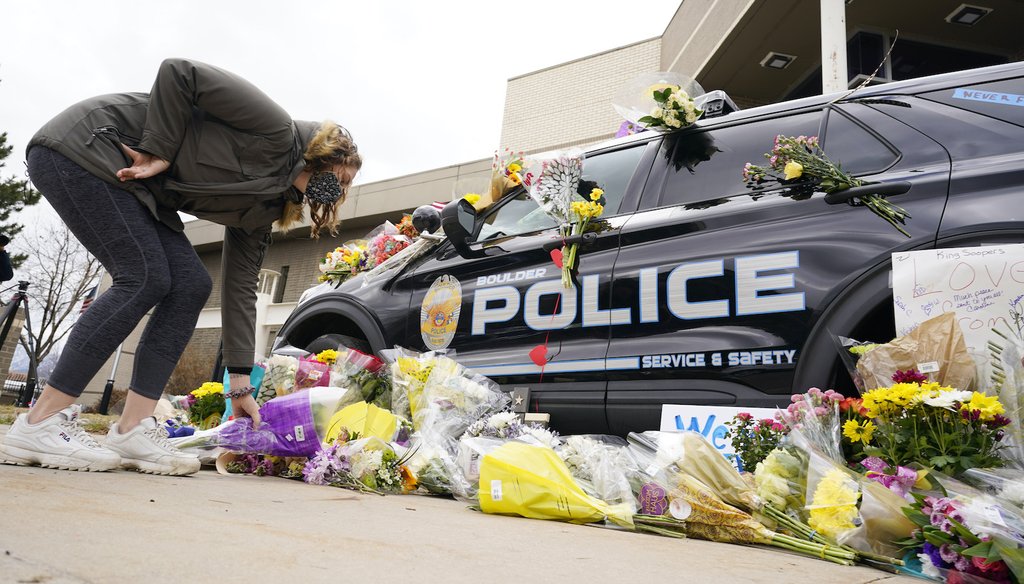Stand up for the facts!
Our only agenda is to publish the truth so you can be an informed participant in democracy.
We need your help.
I would like to contribute

A woman leaves a bouquet of flowers next to a police cruiser parked outside the Boulder Police Department after an officer was one of the victims of a mass shooting at a King Soopers grocery store Tuesday, March 23, 2021, in Boulder, Colo. (AP Images)
If Your Time is short
-
We heard from many that the recent mass shootings in Georgia and Colorado may be a return to a new, sad “normal” as more people are vaccinated against COVID-19.
-
But while firearm-related events where at least four people are killed basically stopped during the pandemic, gun violence actually spiked in 2020.
-
By one definition, more mass shootings occurred in 2020 than in any recent year in American history.
A week after a gunman shot and killed eight people in Georgia, a gunman opened fire in a grocery store in Boulder, Colo., killing 10 people, including a police officer.
After a year of social distancing and closures from the COVID-19 pandemic, the tragedy of two mass shootings, less than a week apart, led politicians and social media users to worry aloud about what a return to everyday American life will really be like.
"We’ve been looking forward to so many ways we could return to normal, to the way things were before the pandemic," tweeted Rep. Ted Deutch, D-Fla. "Mass shootings were not what anyone had in mind."
One Twitter user put it more bluntly: "The only thing that kept mass shootings down in 2020 was a pandemic. That is horrifying."
Is it true that mass shootings tapered off during the pandemic?
According to gun violence researchers, the answer to that question depends on what definition you use.
Large-scale public mass shootings, like those that just occurred in Georgia and Colorado, did indeed decline throughout the pandemic. However, other forms of gun violence rose dramatically over the past year. Under one interpretation, more mass shootings occurred in 2020 than in any other year in recent U.S. history.
There is no universally agreed-upon definition of a mass shooting, and groups tracking gun violence have different understandings of the concept.
One common definition of a mass shooting is based on the old FBI definition of a "mass murder" — an incident in which four victims are shot and killed. Gun violence databases that abide by this definition have reported that the number of large-scale public mass shootings declined sharply during the pandemic.
One such database, compiled by the Associated Press, USA Today and Northeastern University, found that two mass shootings occurred in 2020, down from eight or nine per year during the previous three years. And both of the 2020 shootings took place before pandemic lockdowns were instituted in the U.S.
However, some researchers say that the FBI-inspired definition offers a limited picture of gun violence in the U.S. These researchers prefer a more expansive definition, which defines a mass shooting as a firearm-related incident that results in four or more individuals shot, rather than killed.
The Gun Violence Archive, a nonprofit research group that monitors gun violence through news articles and police reports, uses the broader definition of a mass shooting. This allows the organization to track shootings typically excluded from other mass shooting statistics, such as domestic shootings, as well as forms of gun violence that occur disproportionately in predominantly Black neighborhoods. An analysis by the Trace, a publication that reports on gun violence, found that nearly 50%of mass shootings — defined as at least four people shot, not killed — took place in majority-Black census tracts.
By this definition, 2020 was the most violent year since the Gun Violence Archive first started tracking gun deaths in 2013. According to the organization, 611 mass shootings took place in 2020, exceeding any other recent year by more than 50%.
In fact, many forms of gun violence spiked during the coronavirus pandemic, with the number of overall gun homicides at its highest rate in over 20 years. Much of the violence was centered in major cities such as New York, Houston and Philadelphia. Homicide rates in Milwaukee, Wis., between January and March 2020 were twice as high than in the same period in 2019.
However, many of these mass shootings, which disproportionately featured Black victims, tend to receive less coverage in the media than the high-profile public killing sprees that subsided in the wake of the pandemic.
The reasons for this are varied and complex. University of Texas-Austin professor Michael Sierra-Arévalo said that the phenomenon is rooted in the way that the media often devalues the lives of Black and brown people. As evidence, he pointed to a study that analyzed homicides in Chicago and matched them to media stories to analyze which got the most coverage. The study found that Black victims were less likely to receive media coverage than white victims. It also found that the Black victims who were covered were far less likely to be discussed as complex and sympathetic people than white victims.
Nicole Kravitz-Wirtz, an assistant professor who researches violence prevention at the University of California, Davis said that the COVID-19 pandemic likely played a major role in contributing to the rising violence.
"The COVID-19 pandemic worsened many of the underlying conditions that contribute to community gun violence risk — poverty, unemployment, food and housing insecurity — while also taxing many of the systems and interpersonal networks of support in communities that foster safety, health and wellbeing," she said. "These, in combination with the pandemic’s unique effects on feelings of uncertainty and hopelessness, likely had an impact on the increase in interpersonal community gun violence over the past year."
Staff writer Gabrielle Settles contributed reporting.
Our Sources
Tweet, Mar. 22, 2021
Associated Press, In a year of pain, one silver lining: fewer mass shootings, Dec. 29, 2020
Gun Violence Archive, Past tolls
Britannica ProCon, U.S. gun deaths by year, Aug. 29, 2018
The Conversation, US gun violence: too many people have died in 2020 – and COVID played a larger part than you think, Dec. 9, 2020
The Trace, Mass shootings are soaring, with Black neighborhoods hit hardest, Sep. 3, 2020
The Trace, A historic surge in gun violence compounds the traumas of 2020, Dec. 21, 2020
Sociology of Race and Ethnicity, Whose Lives Matter? Race, Space, and the Devaluation of Homicide Victims in Minority Communities, Sep. 17, 2020






















